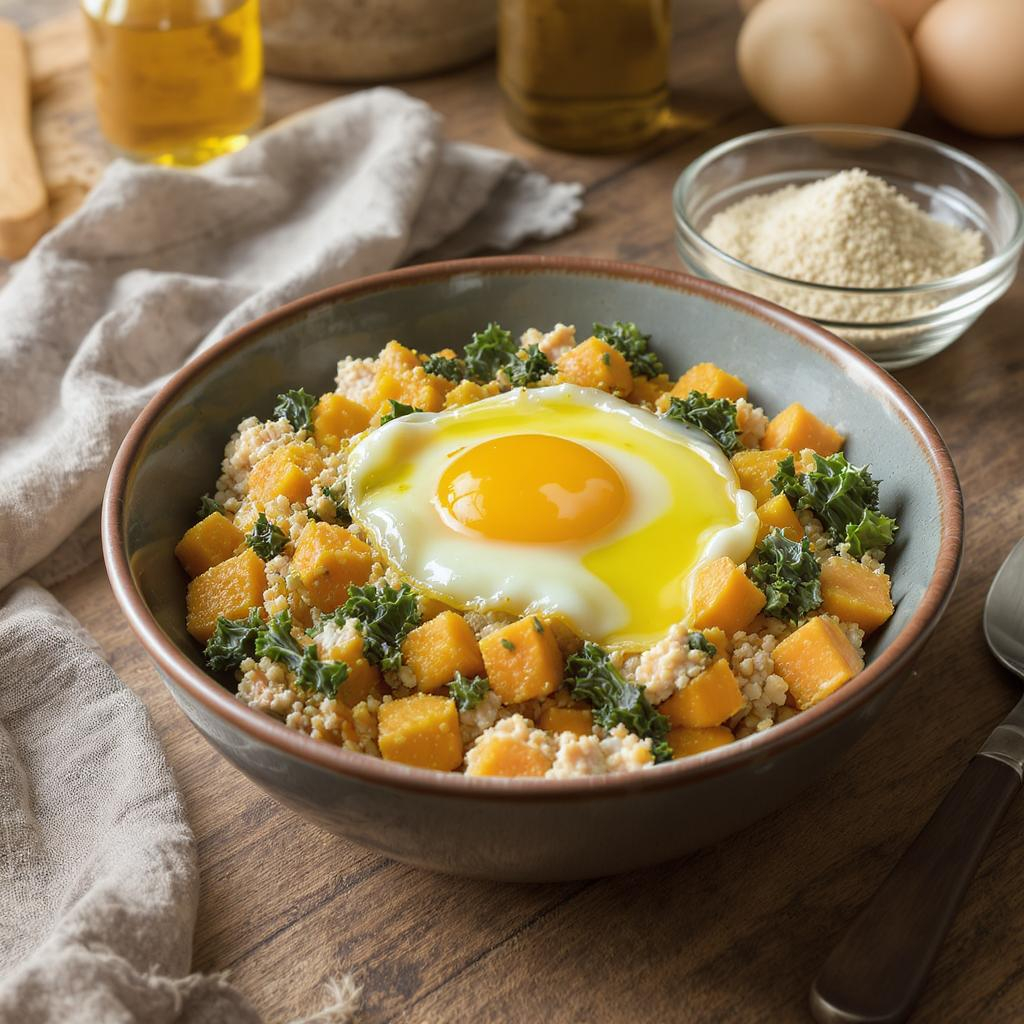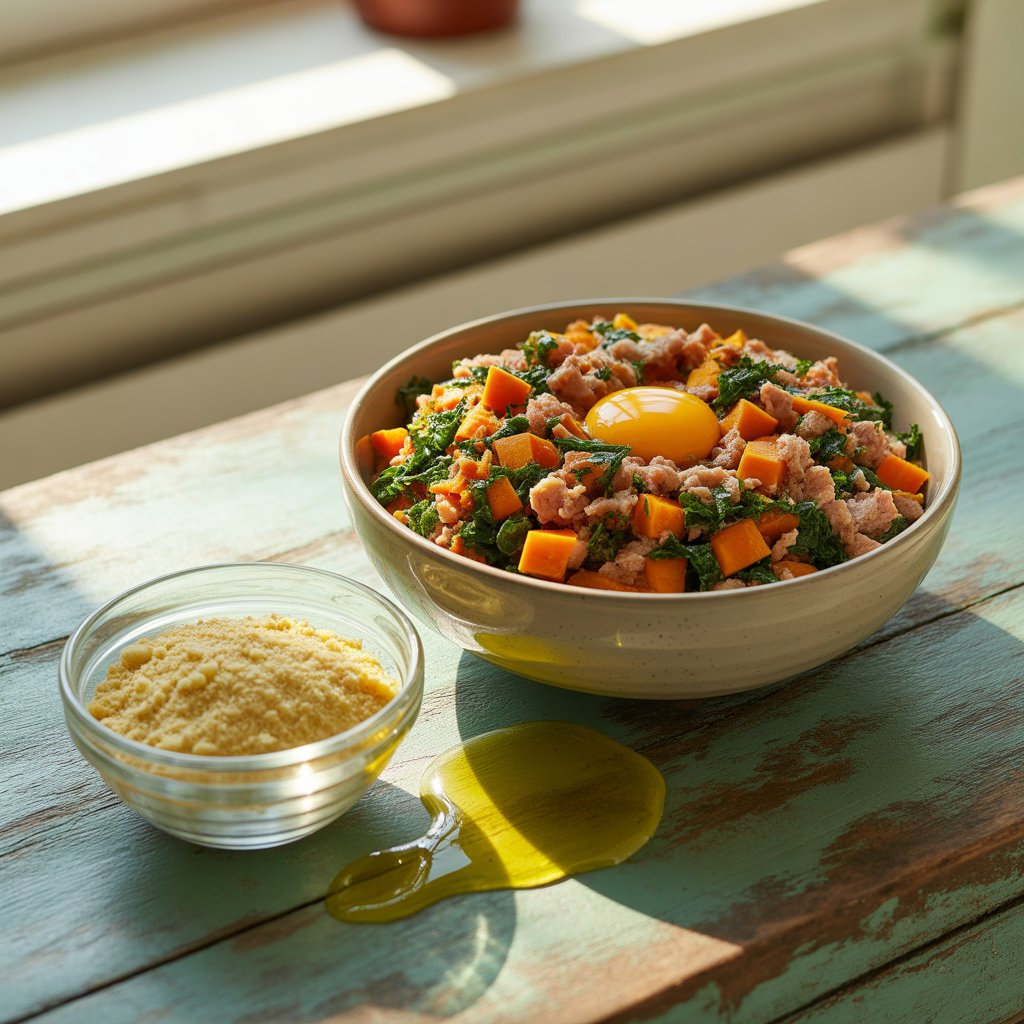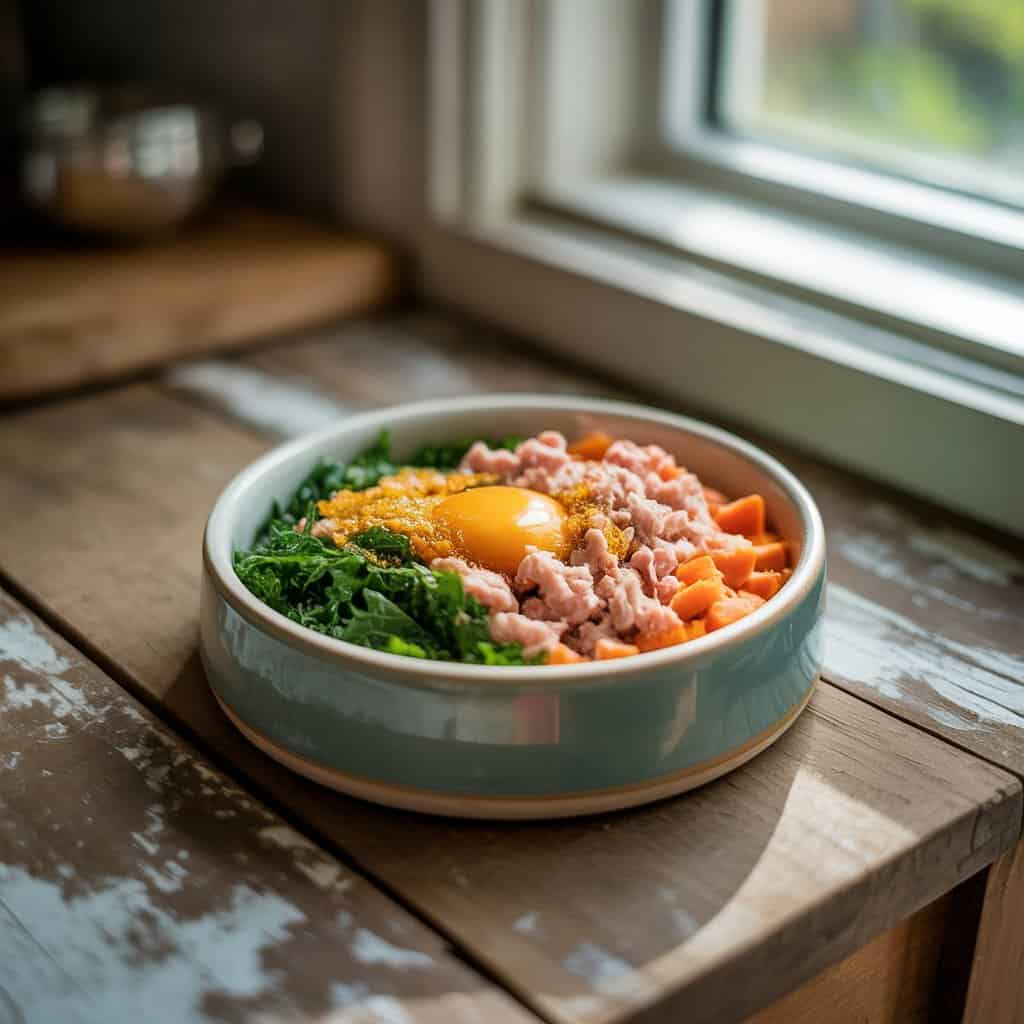Introduction
Many homemade dog food parents that I talk to have this big concern about not having a nutritionally balanced homemade pet food recipe, and rightfully so. So much of the information you might read on the internet, coming from veterinarians, says it has to be nutritionally balanced. Many of those same people say, “When in doubt, eat this kibble; it’s ‘balanced.’” But in my opinion, I really feel that most homemade diets are far healthier. You’re making fresh ingredients, you know what’s going into them, and they’re not toxin contaminated.
Start with Good Quality Protein
You need to start with a good quality protein, focusing on lean beef, lean chicken, and lean turkey, including eggs that have a high-quality, balanced amino acid profile. We want the animal protein to be the primary part of the diet, and that’s the first thing we’re focusing on for this video. Often, what I feed Tula is ground turkey, which is an awesome source of protein, and I add in an egg, which has a balanced amino acid profile.
In making this recipe, I would start with one pound of ground turkey and add in one to two eggs.
Add Carbohydrates
Carbohydrates are not needed to be part of your dog’s diet, but I would prefer you choose one of the healthy carbohydrates, be it ground rice, potato, or sweet potato. I’m choosing sweet potato for today’s recipe, and in particular, they also provide some really good key nutrients.
This sweet potato here is rich in fiber, protein, vitamins A, C, and E, the B vitamins, and potassium. In making a recipe for Tula, I’d be adding in one cup of sweet potato.
Add Healthy Fats
Every dog’s diet must include fats to support energy and general health. The skin, coat, and immune system of your dog depend on the proper ratio of omega-6 and omega-3 fatty acids, which can be maintained by using sunflower oil. Vitamin E, an antioxidant that your dog needs in their regular meals, is also abundant in sunflower oil.
Coconut oil is an additional choice that offers natural vitamin E and healthy fats. One tablespoon of oil for each pound of meat is an easy rule to follow. Therefore, you will add one tablespoon of oil to your recipe if it calls for one pound of ground turkey.

.
Add Omega-3s for Extra Support
Omega-3 fatty acids are beneficial for your dog’s joints, coat, and heart health. One easy way to include these is by adding krill oil to your recipe. A typical amount is 500 milligrams for every 20 pounds of your dog’s weight each day. For Tula’s portion, I add one krill oil tablet after the food has finished cooking.
Don’t Forget Calcium
If you’re not feeding your dog bones, you will need to add calcium in some form of a supplement to make this a balanced diet. I prefer calcium in the form of ground eggshell, which is inexpensive, and since eggs are part of the recipe, it is easy to include.
To make ground eggshell for your dog’s food, first rinse the eggshells and place them in the oven for 10 to 15 minutes to dry them out. Once they’re dry, grind them into a fine powder using a coffee grinder. After you’ve cooked the meat, sweet potatoes, and vegetables, add about half a teaspoon of the ground eggshell per pound of meat, which will provide around 1000 milligrams of calcium for your dog’s meal.
Add Vegetables
Remember what your mother always said: you have to eat your veggies. Dark green leafy vegetables are probably the best ones to add. I prefer kale over spinach, as it is rich in vitamins A, C, and minerals like calcium, zinc, and potassium, which are key nutrients for your dog’s diet.
You also get flavonoids and gluten from kale. When making this for Tula, I add about one chopped cup of lightly steamed kale. Watch a video about it.
Add Fiber
Fiber is important for your dog’s gut health. If you are using kale, spinach, or sweet potato, you already add some fiber, but I prefer ground flaxseed as an additional fiber source. It is easy to use and beneficial.
A standard amount is about one teaspoon per cup of food fed daily, and Tula gets one or two teaspoons a day.
Key Vitamins and Minerals
Vitamin D
Vitamin D is high in egg yolk, so if you are adding eggs, your vitamin D requirement is covered.
Vitamin E
Sunflower oil is rich in vitamin E, so using it in your dog’s food covers vitamin E needs.
B Vitamins
B vitamins are essential for brain and nerve health and are found in kale and sweet potato.
Iron
Iron is available in the meat you add and also in kale.
Zinc
Zinc is in animal proteins and ground flaxseed.
Iodine
Iodine is essential for thyroid health, and egg yolks are rich in iodine.
Potassium
Potassium is abundant in sweet potatoes, ensuring your dog gets this essential mineral.
Simplifying Homemade Dog Food with Supplements
If you don’t want to worry about measuring vitamins and minerals, you can make a balanced recipe with animal protein, sweet potato, carrots, and kale. To ensure all the vitamins and minerals are covered, I suggest using Dr. Jones’s Ultimate Canine Advanced Health Formula, a complete multivitamin and mineral supplement with added key ingredients for keeping your dog healthy and naturally preventing disease.

.
Supplies You Need
Before you start, gather your supplies:
- A giant 14-cup stockpot for making a week’s worth of food for a 40-50 lb dog (you can also use a pressure cooker or crockpot)
- A blender, food processor, grinder, or knife and cutting board to chop meat and vegetables for a ground mixture
- Gallon freezer bags for bulk storage
- Smaller meal-sized bags for portioning
Adjusting the Recipe for Your Dog’s Weight
This specific recipe is designed for a 40 lb dog. At the end of the preparation, you can easily adjust the amounts to suit your dog’s weight and needs.
If you want to get the correct amounts for your dog’s weight, visit effortwiz.com for practical homemade diet guides and portion charts so you can confidently and naturally feed your dog.
FAQs About Homemade Dog Food
1. Why consider homemade dog food?
Homemade dog food allows control over ingredients, ensuring freshness and avoiding unnecessary fillers and additives often found in commercial dog food.
2. What protein sources work best in homemade dog food?
Lean meats like chicken, turkey, and beef, along with eggs, are excellent protein sources that support muscle health and energy in dogs.
3. Are carbohydrates necessary in homemade dog food?
Carbohydrates are not essential but can be included for added nutrients and fiber. Options like sweet potatoes, rice, or regular potatoes are commonly used.
4. Why are fats important in a dog’s diet?
Fats provide energy, support skin and coat health, and aid nutrient absorption. Adding healthy oils like sunflower oil or coconut oil ensures dogs receive essential fatty acids.
5. How can omega-3 fatty acids be included in homemade dog food?
Omega-3 fatty acids, which support coat, joint, and heart health, can be added using krill oil or fish oil after cooking the food.
6. Why is calcium needed in homemade dog food?
Calcium is essential for strong bones and teeth. If bones are not included in the diet, ground eggshell powder can be added as a calcium source.
7. How can ground eggshell powder be prepared?
Eggshells can be rinsed, baked for 10–15 minutes to dry, and ground into a fine powder. This powder can then be added to the food to supply calcium.
8. What vegetables can be added to homemade dog food?
Vegetables like kale, spinach, and carrots add vitamins, minerals, and fiber to support a dog’s immune system and digestive health.
9. How should homemade dog food be stored?
Homemade dog food should be portioned and stored in airtight containers in the refrigerator for up to three days or frozen for longer storage.
10. How can portion sizes be determined for homemade dog food?
Portion sizes depend on a dog’s weight, age, and activity level. It is helpful to use a portion guide or consult a veterinarian to ensure proper feeding.
11. Can supplements be added to homemade dog food?

Supplements can help fill nutritional gaps in homemade dog food, ensuring dogs receive essential vitamins and minerals for balanced health.
12. Is it safe to switch a dog to homemade food immediately?
It is recommended to transition gradually over 7–10 days, mixing homemade food with the current food to prevent digestive upset.
.
Final Notes
95% of homemade dog food recipes, even those developed by veterinarians, are deficient in at least one major nutrient. That’s not good enough for us, so today, we have shown you how to make, store, and feed one week’s worth of fully balanced homemade dog food, so you can be confident that this food has everything your dog needs.
Thanks again for watching this video. I will put specific descriptions of all these discussed ingredients below. I also encourage you to sign up for my new dog webinar, How to Stop Common Dog Problems at Home with Pet Food Supplements and My Specific Natural Remedies. Click the link in the box below for more information on effortwiz.com.
Puppy Dog Eyes,